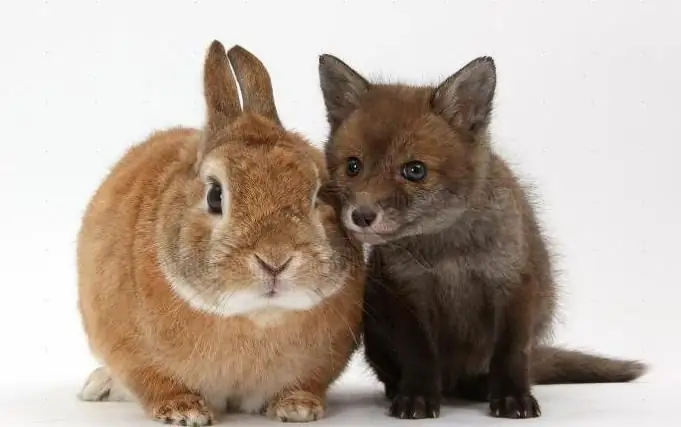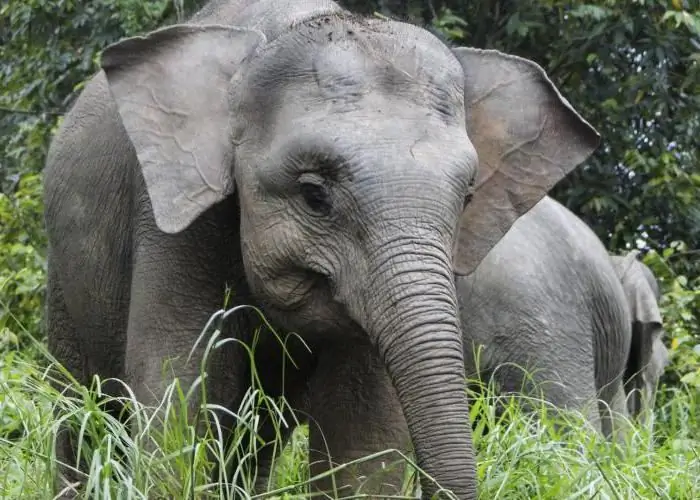2025 Author: Priscilla Miln | [email protected]. Last modified: 2025-01-22 17:55:20
Did you know that there is a pygmy elephant? Photos of pygmy elephants just flooded the Internet. Fans of these cute animals are already fantasizing that such a baby can definitely be kept as a pet in an apartment. Let's see if a pygmy elephant can live at home, what he eats, how he behaves in the wild.

Habitat
The smallest elephants on our planet live in Borneo. It is the third largest island in the world and the largest in Asia. On its territory there are borders of three countries - Indonesia, Malaysia and Brunei. Almost the entire territory of Borneo is covered with dense equatorial forests, there are areas where no human has set foot. Perhaps the island still has animal and plant species that modern biologists know nothing about.
Borneo pygmy elephants live only on a small part of the island belonging to Malaysia, in the state of Sabah. Sometimes you can meet these amazing animals on the territoryIndonesia. The habitat of pygmy elephants is associated with their food preferences.
Borneo dwarf elephants feed on various greens: herbs, juicy palm leaves, wild bananas, bark, nuts, various fruits, seeds. Also, these animals need minerals that ensure their harmonious development. Elephants get their minerals from s alt licks and other limestone deposits that can be found along river banks.

What size are they
The smallest elephants in the world are a subspecies of Asia. The pygmy elephant, whose photo you can see in this article, lives in the northeastern part of the island. What are the features of the appearance of these animals?
Many are interested in how tall a pygmy elephant is. Its dimensions are not as miniature as it seems from the name of the subspecies. The growth of an adult pygmy elephant is 2-2.5 meters. Weight can reach 2-3 tons.
For comparison, here are the sizes of the closest relatives, Asian elephants, which reach 3.5 meters in height and can weigh up to 4.5 tons.

The largest African elephant in history weighed over 12 tons and was almost four meters tall. As can be seen from the comparison, the Borneo elephant is indeed considered a dwarf compared to its brethren, but is still a large animal.
Appearance features
In addition to their modest size, pygmy elephants are distinguished by some characteristic featuresappearance. Their ears are larger than those of Asian elephants, the spine is more curved. The tusks are short and straight. But the tails are long, almost touching the ground. There is another difference, thanks to which the pygmy elephant is so popular. The photos perfectly demonstrate the cute cartoon expression of the muzzle. Thanks to this feature, it is simply impossible to confuse a pygmy elephant with an animal of another subspecies.
However, despite their cute appearance, Borneo elephants are large wild animals. There are known cases of their attacks on people, including fatal ones.

Genetic origin theory
How did this rare elephant appear and how did it get to the island of Borneo? Scientists cannot give an exact answer to this question. There are two theories as to where the Borneo pygmy elephant originated.
The first hypothesis is based on laboratory studies of the DNA of these animals. Genome analysis tells us that elephants live in isolation, and have not met with their relatives for more than 300 thousand years, which means that they are an independent subspecies.
Distant ancestors of pygmy elephants came to Borneo during the global cooling period, about 18,000 years ago. Presumably, they passed through the land isthmus, which was later destroyed. Thus, all elephants descended from the same group, and changes in appearance and slight differences from other Asian relatives are the result of long-term isolation.
This hypothesis is very plausible, but it fails to explain one interesting fact:Borneo has not found archaeological evidence of elephants living for such a long period. The oldest remains date back to the 18th century.

Historical origin theory
Where, and most importantly, when did the pygmy elephant appear in Borneo? This explains the second hypothesis, according to which the progenitors of the island elephants were presented to the local Sultan of Sulu by the ruler of Java. Thus, the inhabitants of Borneo are the descendants of Javanese elephants, which are considered extinct. It remains a mystery how a few animals were able to start a vast population in three hundred years.
Existential threat
Today, the pygmy elephant is under threat of extinction. A lot of efforts are directed to save these rare animals. For a long time, small groups of elephants hid in dense forests, with little or no human contact.
However, as a result of constant deforestation and expansion of agricultural land, wild elephants are increasingly confronted by people, resulting in casu alties on both sides. Poachers who hunted for tusks also played their role in the disappearance of a rare species. Also, young animals are constantly attacked by predators. Today, the population has about 1,500 individuals, which means that the life of each animal is of great importance.

Behavior
Borneo pygmy elephants are social animals. They live in groups with complex family ties. The family herd consists of the oldest and most experiencedfemales, her sisters, daughters, that is, relatives of the head of the herd. In rare cases, other females who are not blood relatives may join them. Such a group can consist of 3 to 25 individuals.
A group of females sometimes unites with a group of males and lives as a single clan. All female elephants help each other in raising their young. More experienced mothers show the young how to properly care for offspring. The survival rate of elephant calves increases significantly when several females look after them.
Relationships in the group
Elephants are known to form strong social and emotional bonds with members of their herd. Family values are very important to them. They can carry friendship and good relationships throughout their lives, mourn the loss of loved ones and cubs. Elephants may return to the site of a herd member's death to mourn.
The herd going to the watering hole looks touching. Baby elephants grab their mother's tail with their trunks to keep up, and other elephants surround the babies to protect them from possible danger.
Despite warm relations and strong bonds between members, the group may split. The reason for this is usually a lack of food, water, or a conflict within the herd associated with the death of a leader. Herds living in the same territory do not conflict, greet each other and can interact. If conditions are favorable, water and food are plentiful, then groups can unite.

Clans
Mature males separate from the mother group andlead a solitary nomadic life. As they grow older (puberty occurs at 12-15 years old), males become more and more independent, begin to leave the herd and wander alone. Over time, the male is completely weaned from his herd. He can continue his life alone or join a group of other males.
The male clan also has a strict hierarchy. The group is led by the most mature and experienced males. Members of the herd stick together, but as soon as one of them has a female who has accepted courtship, he leaves his male group for the duration of the mating season.
In captivity
Having your own pygmy pet elephant is the dream of many animal lovers. However, if you carefully read the article, you managed to understand that even the smallest elephants in the world are huge animals weighing several tons.
What conditions would you have to create if you had a pygmy elephant? The pet is massive, and therefore eats a lot. Every day, the happy owner of such a pet needs to get at least 150 kilograms of a variety of green food.
In their natural environment, elephants are in constant motion. Accordingly, they need a huge aviary. Also, the animal needs somewhere to swim, take mud baths, rub against trees, wallow in the sand, walk on the grass. During the cold season, it should be kept indoors.
Dwarf elephants are amazing and very rare animals that can be found only in a small area of the island of Borneo. Their origin is unknown, but theyare a separate subspecies and are carefully studied by scientists.
Recommended:
Business folder: description, dimensions, material, photo

It is rational to use folders or envelopes to carry documents and papers. This will protect the paper from deformation and damage. They will stay intact and will not wrinkle. Folders are used for carrying or storing large amounts of materials. It is convenient to place interrelated documents in them, for example, reports for a period or a catalog of goods, a list of employees and other information
Dwarf rabbit: photo, care and maintenance at home, reviews. Sizes, types of dwarf rabbits. How long do dwarf rabbits live?

These adorable creatures can't help but amaze. A dwarf rabbit with beady eyes, funny ears and unusual habits delights animal lovers
Tape cassette: description, photo, dimensions, purpose and principle of operation

With the advent of digital audio recording, the tape recorder, like its relatives (floppy disks with vinyl records), soon turned into stylish pictures, having lost its original meaning. Let's not write it off and find out what it was made of and how it works. And also consider what can be done from old cassettes that have become obsolete
Do-it-yourself cat stand: dimensions, photo

Cats are animals that walk by themselves, even if their walks are limited to outside the apartment. The owners of fluffy and purring ones try to make their life as bright and memorable as possible by buying various toys and sweets. It's time to show all your love and devotion to the woolen overlords: it's time to create a stand for a cat with your own hands. How to do this, what is needed for this and how to please a furry pet - we will tell in the article
Dwarf chickens: breeds, prices. Dwarf laying hens

Dwarf chickens are becoming more and more common in our backyards. What is the reason for this growing popularity? Among these babies there are both decorative and productive egg-laying and meat breeds, which are small copies of large species

